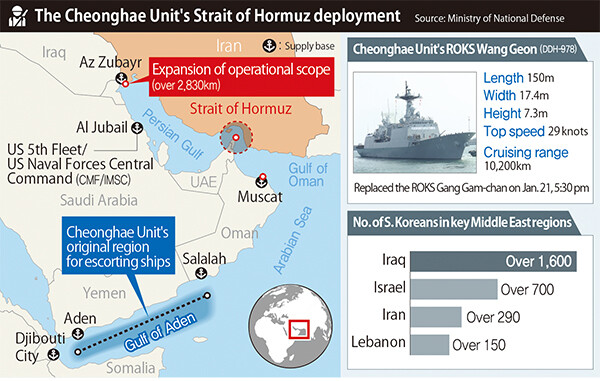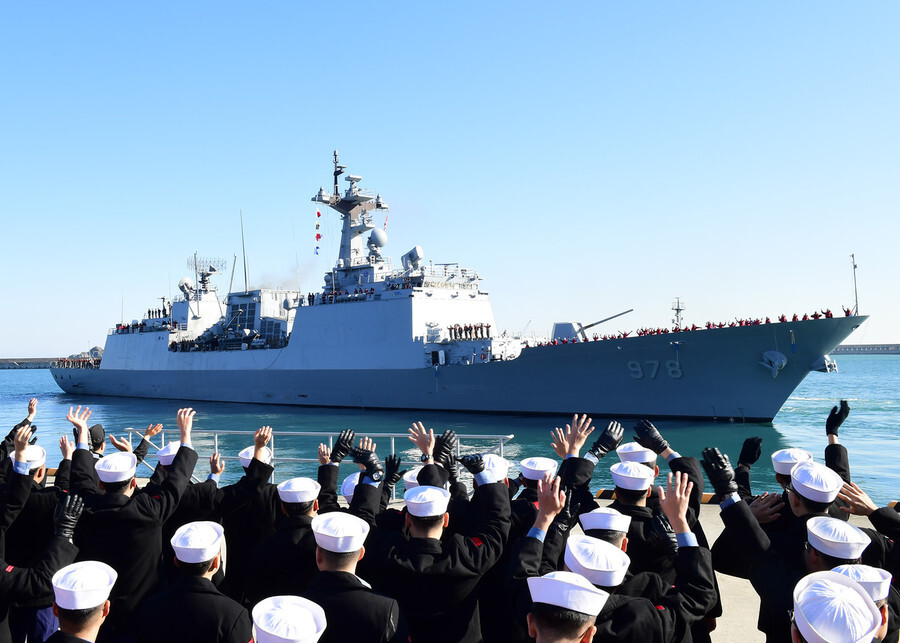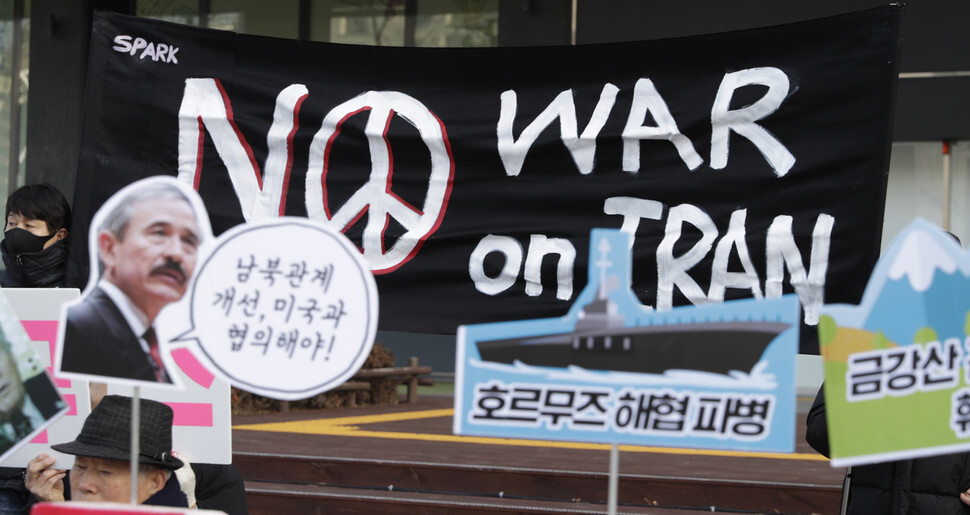hankyoreh
Links to other country sites 다른 나라 사이트 링크
[News analysis] S. Korea tries to appease both US and Iran with Strait of Hormuz deployment

The South Korean government’s decision on Jan. 21 to deploy military forces to the Strait of Hormuz by expanding the operational scope of the Cheonghae Unit will dispatch a South Korean combat unit into a disputed region for the first time since the Vietnam War. While South Korean forces are currently stationed in 12 countries, including Lebanon and South Sudan, they’re either keeping the peace or performing support roles such as rebuilding and education. Even the South Korean troops deployed to Iraq in 2003 weren’t part of a combat unit. This makes clear the risk behind the government’s decision.
Seoul’s decision can be seen as an attempt to walk a tightrope between the demands of its ally, the US, and Iran’s status as a major trading partner. This brings to mind South Korean President Moon Jae-in’s promise during his New Year’s press conference on Jan. 14 to find a “practical solution” that accounts for relations with both countries. Seoul seems intent on minimizing a backlash from Iran by not joining the US-led International Maritime Security Construct (IMSC), a naval coalition aimed at keeping the Strait of Hormuz safe, while still acceding to American demands by expanding the Cheonghae Unit’s operational scope to include waters inside the Strait of Hormuz.
Since last summer, the US has been seeking to organize an international coalition to maintain security in the Strait of Hormuz and asking South Korea to contribute forces to such a coalition. During a meeting in San Francisco on Jan. 14, US Secretary of State Mike Pompeo made the case for joining the coalition while explaining Middle East affairs to South Korean Foreign Minister Kang Kyung-wha. The US hasn’t publicly asked South Korea to join the IMSC, but it’s clear that Washington wants Seoul on board.
At one point, Seoul was reportedly considering a range of scenarios, one of which was joining the IMSC. But after military tensions in the region were heightened by the US’ elimination of Qasem Soleimani, a top commander in Iran's Revolutionary Guard, in early January, followed by Iran’s missile attack on bases in Iraq housing American soldiers, South Korea became more cautious.
“Considering that Japan, another US ally in Asia, had already decided to send forces independently to the Strait of Hormuz, our government probably felt that it couldn’t keep putting off its decision. Making an independent deployment was basically predetermined given the fact that we can’t become an enemy of Iran,” a source in the military said.

Some predict that the government’s decision, since it partially conforms to American demands, will provide impetus for Moon’s plans for inter-Korean relations and help lead to a breakthrough in the two countries’ negotiations over defense cost-sharing. American Ambassador to Seoul Harry Harris recently emphasized that the Moon administration needs to discuss its plans for inter-Korean cooperation with the US to ensure they don’t fall afoul of the sanctions regime. Inside South Korea, there are likely to be questions about the legitimacy of sending military forces at the US’ request and of the need to secure the National Assembly’s consent for expanding the Cheonghae Unit’s operational scope.
The government’s decision expands the Cheonghae Unit’s area of operations from the Gulf of Aden to include the Gulf of Oman and the Persian Gulf, effectively more than tripling that area. With that in mind, the military has reportedly been using Muscat, the capital of Oman, as the Cheonghae Unit’s primary port of call since July 2019. There are also concerns that, if the unit’s operational scope is too large, it will be less capable of responding to multiple simultaneous incidents.
Cheonghae Unit’s cooperation with US-led IMSC is inevitableWhile the Cheonghae Unit will ostensibly operate independently, cooperation with the US-led IMSC is inevitable. To enter the Persian Gulf from the Gulf of Oman, it’s necessary to pass through the Strait of Hormuz, which is controlled by Iranian forces. The deployment of liaison officers to the IMSC can be seen as a way to arrange such cooperation.
“We will cooperate with the IMSC if a situation arises that exceeds the capabilities of the Cheonghae Unit,” a source in the military said.
Seoul explained that the Cheonghae Unit will only be escorting South Korean ships in the area of the Strait of Hormuz, and that those duties will be overseen by the South Korean military. If threats are identified, such as indications of an attack by enemy forces, the Cheonghae Unit will presumably be commanded by the Joint Chiefs of Staff.
“Other countries only escort their own ships through the Strait of Hormuz. While performing its duties, the Cheonghae Unit won’t exceed its limitations or capabilities,” said an official at South Korea’s Ministry of National Defense.
But the Cheonghae Unit would be forced to defend itself if attacked in the Strait of Hormuz, a fact that prompts concerns about South Korea being embroiled in an armed conflict. Before departing from the Busan Naval Command last month, the ROKS Wang Geon, the 4,400-ton destroyer carrying the Cheonghae Unit, was reportedly outfitted with anti-submarine weaponry, including torpedoes and a sonar detection system.
“We’ve prepared response guidelines that take into account a number of contingencies in the Strait of Hormuz,” a military source said.

While Seoul stressed that the Cheonghae Unit’s expanded operational scope is “temporary,” it didn’t nail down a timeframe. In effect, the government has opted not to limit the deployment period. This may be aimed at leaving room for the government to make an intuitive decision about whether to terminate the deployment. Such a decision would likely be affected by situational changes, such as the easing of military tensions between the US and Iran.
By Yoo Kang-moon, senior staff writer
Please direct comments or questions to [english@hani.co.kr]
Editorial・opinion
![[Correspondent’s column] The real reason the US is worried about Chinese ‘overcapacity’ [Correspondent’s column] The real reason the US is worried about Chinese ‘overcapacity’](https://flexible.img.hani.co.kr/flexible/normal/500/300/imgdb/original/2024/0510/5217153290112576.jpg) [Correspondent’s column] The real reason the US is worried about Chinese ‘overcapacity’
[Correspondent’s column] The real reason the US is worried about Chinese ‘overcapacity’![[Editorial] Yoon’s gesture at communication only highlights his reluctance to change [Editorial] Yoon’s gesture at communication only highlights his reluctance to change](https://flexible.img.hani.co.kr/flexible/normal/500/300/imgdb/original/2024/0510/7717153284590168.jpg) [Editorial] Yoon’s gesture at communication only highlights his reluctance to change
[Editorial] Yoon’s gesture at communication only highlights his reluctance to change- [Editorial] Perilous stakes of Trump’s rhetoric around US troop pullout from Korea
- [Guest essay] Preventing Korean Peninsula from becoming front line of new cold war
- [Column] The state is back — but is it in business?
- [Column] Life on our Trisolaris
- [Editorial] Penalties for airing allegations against Korea’s first lady endanger free press
- [Editorial] Yoon must halt procurement of SM-3 interceptor missiles
- [Guest essay] Maybe Korea’s rapid population decline is an opportunity, not a crisis
- [Column] Can Yoon steer diplomacy with Russia, China back on track?
Most viewed articles
- 1Korea likely to shave off 1 trillion won from Indonesia’s KF-21 contribution price tag
- 2Nuclear South Korea? The hidden implication of hints at US troop withdrawal
- 3[Editorial] Perilous stakes of Trump’s rhetoric around US troop pullout from Korea
- 4With Naver’s inside director at Line gone, buyout negotiations appear to be well underway
- 5In Yoon’s Korea, a government ‘of, by and for prosecutors,’ says civic group
- 6[Column] ‘Choson’: Is it time we start referring to N. Korea in its own terms?
- 7‘Free Palestine!’: Anti-war protest wave comes to Korean campuses
- 8How many more children like Hind Rajab must die by Israel’s hand?
- 9Overseeing ‘super-large’ rocket drill, Kim Jong-un calls for bolstered war deterrence
- 10[Photo] ‘End the genocide in Gaza’: Students in Korea join global anti-war protest wave